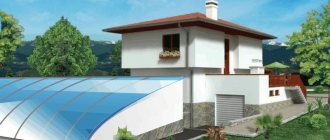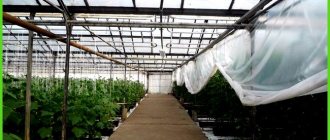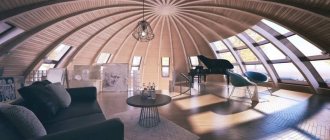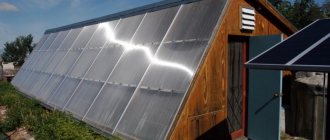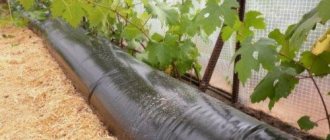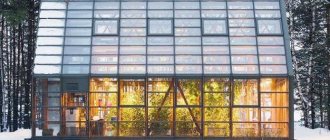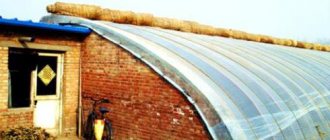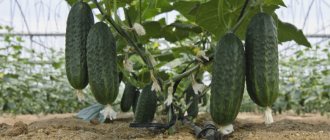Instead of a traditional greenhouse, summer residents usually think about a solar growing season in which late blight comes especially early in the region, and it is difficult to prolong the growing season of tomatoes. Moreover, it is not difficult to build this architectural miracle and at the same time a brilliant creation for an ordinary physics teacher - even if you don’t hire anyone and don’t study Soviet textbooks. So, do-it-yourself solar vegetarian!
Why is a solar greenhouse better than conventional greenhouses? It has quite a lot of advantages:
- The lion's share of the time, no more than 35% of solar energy enters an ordinary greenhouse - if it is arched, and 20% - if it is of a different shape. In vegetarianism – many times more!
- In the summer heat, an ordinary greenhouse has to be intensively ventilated, but in this way carbon dioxide and moisture are almost completely removed from it - and they are vital for plants.
- An ordinary greenhouse without an expensive heating system loses heat very quickly - as soon as frost appears. A proper solar vegetarian is designed in such a way that such temperature fluctuations in it are much more smoothed out.
And the most important thing is that the sun's rays hit the inclined roof of the vegetarian garden at a right angle and therefore are practically not reflected. All the energy ultimately goes to heating and lighting the greenhouse, and it turns out to be 4 times more than in a regular greenhouse in the warm season, and 18 times more than in winter and at night. Impressive, isn't it? It’s not for nothing that they say that a solar vegetarian is a new generation greenhouse!
Stage I. Designing a solar vegetarian
The back wall in the vegetarian room is traditionally made of solid material, with mirror reflective material. Thanks to which up to 95% of heat and light energy will be returned to the plants - that’s the secret! In this regard, studies have even been conducted that in central Russia, when the soil of a vegetable garden is sloped, the sun's rays are absorbed by 32% more in the winter season - and this is undoubtedly a more solid harvest.
This wall can also be a blank wall of the house, or simply covered with boards. She is always northern. You can insulate it with ordinary polystyrene foam - the main thing is to protect it well from mice. It is closed, in turn, with foil insulation, which can be easily attached with a construction stapler. The size of the solar vegetable garden is determined individually, depending on the planned budget and the capabilities of the site for construction.
A garden miracle with fantastic possibilities
Solar vegetarian is a new generation greenhouse, a type of solar greenhouse introduced by physicist A.V. Ivanov. The structure was constructed back in the 50s of the last century, and immediately demonstrated the fantastic possibilities of obtaining large yields in any climatic zone.
Growing vegetable garden crops allows you to get a harvest a month earlier, and its size increases several times.
IMPORTANT: The solar greenhouse will allow you to grow on your own plot not only traditional crops for Russia, but also very exotic plants, the cultivation of which is impossible in a regular greenhouse.
The appearance of this structure
resembles an ordinary wall-mounted greenhouse , often found in many summer cottages.
The fundamental difference is the special internal structure of the vegetarian plant. Ivanov’s vegetarian garden is the destruction of all stereotypes of growing heat-loving crops indoors. differs from a conventional greenhouse or greenhouse :
- The vegetarian does not need additional heating at temperatures starting from minus 10 degrees. Inside the structure under such conditions, the temperature will remain within 18-20 degrees. If there are night frosts down to minus 15, a balance of plus 12 degrees is maintained inside;
- The Ivanov solar greenhouse is equipped with a special air circulation system . The interior of the vegetarian space does not require ventilation. What is especially important is that during this procedure the greenhouse loses moisture, nitrogen and carbon dioxide, and the presence of these substances in the air is necessary for the full development of plants;
- In the vegetarian garden optimal humidity for plants , so there is no need for frequent watering.
REFERENCE: Ivanov even grew purely southern citrus fruits on an area of 17 hectares. The yield of tomatoes and cucumbers was 44 kg per square. And this is in the absence of modern growing technologies, invented only in the 21st century.
Stage II. Placement and foundation
The solar vegetarian, created and tested 60 years ago by the genius inventor Ivanov, should be placed on a natural or artificially created slope from 15˚ to 35˚, the slope of which faces south or slightly southeast. The floor in a traditional shed should be parallel to the roof – and both should be inclined at up to 15 to 35˚. But today, more and more often, Ivanov’s vegetarian garden is being built with a horizontal floor, but an inclined roof - and the harvest is still pleasing, oddly enough.
So, let's move on from theory to practice - the site must be carefully leveled, and you can begin to build the foundation. The best option is bored. To do this, you need to drill 14 holes up to a meter deep and with a diameter of about 20 cm. Fill the holes with concrete and give it time to harden. By the way, the recesses themselves can even be made with an ordinary drill for winter fishing. Only during drilling you need to add a little water so that the soil itself sticks to the drill. In this case, each of these pits will take no more than 15 minutes.
In the finished pits, you need to insert rolled roofing material and pre-prepared reinforcement, which we then weld to the metal frame of the vegetable garden.
Material selection
Sand concrete M300 and asbestos cement pipes for the construction of the foundation of the vegetarian garden
To build a modern version of Ivanov’s vegetarian garden, it is recommended to use only high-quality materials. This will protect the future owner of the greenhouse from damage to the translucent material and load-bearing roof supports.
The following can be recommended as materials for various structural components of the vegetarian plant:
- The foundation is concrete grade M250–300. If desired, you can use ready-made mixtures from the manufacturer. When purchasing, you should carefully inspect the bag. It must be intact, without damage or punctures to the paper.
- Support pipes are asbestos cement products with a diameter of Ø120–150 mm. The height of the building will depend on the length of the pipe. It is advisable to choose products no shorter than 2000 mm.
- Reinforcement - steel rods of at least Ø10–12 mm. For tying reinforcement, it is better to use steel wire Ø0.9 mm.
- The supporting frame is a rectangular steel pipe 40×80 or 60×80 mm with a thickness of at least 4 mm.
Materials for building the frame and frames of the vegetarian garden - Wooden frame - larch block 50×50 or 60×60 mm dried at natural humidity. As a protective composition, it is better to use branded wood impregnations.
- The light-transmitting material is cellular polycarbonate with a thickness of 8 mm for the roof and 4–6 mm for the walls. For installation you will also need an end and connecting profile from the manufacturer.
- Air exchange system - pipes made of low-density polyethylene or polypropylene marked DN125 (Ø125 mm). For turning, branching and transition to a larger pipe, fittings with similar markings are used.
Galvanized self-tapping screws 3x50 mm, M10 bolts 120 mm long with a corresponding nut and washer are used as fasteners. To seal the seams, sealant for external use from branded manufacturers is used.
Calculation of the required material
Edged board 25x200x6000 for making frames for beds and decking for paths
The amount of material needed to build a solar vegetable garden directly depends on its dimensions, the shape of the roof and the depth of the foundation. As an example, we will give the material that is needed to build a greenhouse with an inclination angle of 15° along the ground. In this case, the width of the vegetarian area will be almost 5.2 m, and the length will be about 5 m with a height of 2 m.
The following materials are required for construction:
- concrete - 2 bags of sand concrete M300, 25 kg each;
- asbestos-cement pipes - 9 pieces, 2000 mm long;
- fittings - corrugated rods Ø12 mm with a total length of 30 m;
- steel pipe - 9 pieces 2500 mm long and 3 pieces 5000 mm long;
- edged board - 20 pcs, size 25x200x6000 or 25x225x6000 mm;
- wooden block - 20 pieces measuring 50x50x6000 mm and 10 pieces measuring 50x50x3000 mm;
- HDPE pipe - 5 pcs 5000 mm long and 7 pcs 1000 mm long;
- HDPE fittings - 90° bends in the amount of 15 pcs., tees in the amount of 4 pcs.;
- polycarbonate - the total area of material in sheets is at least 50 m2.
Transparent cellular polycarbonate is an ideal material for roofing a vegetable garden
As a tool for constructing a vegetarian garden you will need:
- earth drill;
- welding machine;
- Bulgarian;
- jigsaw;
- electric drill;
- screwdriver;
- building level;
- hammer;
- set of wrenches;
- container for concrete and water.
If possible, it is better to use a concrete mixer to mix concrete.
Stage III. Frame construction
Ivanov’s solar vegetable garden itself can be made of a wide variety of materials - construction experience shows that both inexpensive structures and especially durable metal cope well with all functions. But the tree does not always feel good in such an ecosystem - its humidity is much higher than in ordinary greenhouses. And a profiled pipe with dimensions of 20x20 and 40x40 cm is ideal for building a vegetarian garden. And here are the tools you will need for the job: screwdrivers, a metal saw and grinders.
When making a solar vegetarian with your own hands, it is better and easier to cook the frame right on the ground - from two parts, 4 m and 6 m. After this, it can already be tied to the poles and connected. It’s also convenient to make a rafter system right there, so that you can then install it one piece at a time. The welded frame must be finally painted with special anti-rust paint - after all, the climate in the vegetarium will be humid.
Air exchange in the greenhouse
The problem of loss of nutrient medium for plants CO2 in the Ivanov building is solved by creating a closed air exchange cycle .
In the depths of the soil, at a distance of about 35 centimeters from the surface and about 60 centimeters from each other, pipes (plastic or asbestos-cement) are hidden. The pipes are laid in a south-north direction. The ends of the pipes from below are brought to the surface of the earth, and the upper ones are connected into a collector located across the pipes.
IMPORTANT: Today, PVC pipes are the most suitable for vegetarians. The main thing is that they are thin-walled and have a diameter of at least 110 mm.
In the center of the collector there is a vertical pipe with a control valve, which goes out to the roof through the northern wall. The outlet of this pipe directly into the vegetarian area is supplied with a fan.
Using dampers installed in the collector (at the top and bottom of the fan), the temperature inside the greenhouse is regulated. In a sunny vegetarian garden in winter, when the temperature outside is minus ten, the internal heat is enough to maintain a temperature of 25 degrees.
The heat accumulator is the soil , which absorbs it from the air. The heat accumulated in the upper part of the structure is artificially redirected downwards. At night, the reverse process of heat transfer from the soil back into the air occurs.
The same greenhouse ventilation system saves plants from overheating on hot days . Excess heat is removed outside using the same pipes. Now the lower damper under the fan closes, and the upper one opens.
In this case, the direction of the supply air flow changes. The fan drives it outside, ensuring a normal internal temperature and protecting the plants from overheating.
REFERENCE: The ventilation system of the vegetarian garden also helps to maintain optimal humidity inside, which significantly reduces the need for watering the plants.
Results
Although the presented ideas for winter greenhouses seem quite different at first glance, they all have common features.
Window
Without light, nothing can grow, so you need to be sure that the material you choose will transmit light well. Rob Avis of Verge Permaculture recommends using a material that allows at least 70% of the sun's rays to pass through.
Insulation
In a regular greenhouse, all the walls are transparent, but this design is not suitable for the winter version of the greenhouse, because on cold, dark nights you need to provide the plants with the maximum amount of heat. That is why all of the above greenhouses have only one wall transparent, while all the others (including the ceiling) are insulated. An excellent and free way to insulate the north wall of a greenhouse is to attach it to the wall of the house. This will not only insulate the greenhouse, but also help keep the house warm. The main thing is to take care of good waterproofing.
If funds allow, you can also insulate the ground near the greenhouse - this will prevent the heat accumulated by the ground during the day from disappearing.
At night or in cloudy weather, the glass wall can be covered with fiberglass or bags filled with leaves.
Ventilation
Winter greenhouses are designed specifically to create optimal conditions for growing plants in the cold season, so it’s not surprising that it gets hot here in the summer
In such structures, it is important to carefully consider ventilation systems and use them wisely on hot summer days
Thermal mass
Thermal, or thermal, mass is the ability of a material to absorb and store thermal energy. With the right materials, you can collect and store heat from the sun during the day and use it to heat your greenhouse at night. Standard materials for thermal mass: water, stones, a mixture of clay and straw, or just earth. Water is a problematic material because it can freeze, but on the other hand, water is one of the most flexible materials, because you can easily regulate its quantity by adding or pouring out excess.
There are 2 ways to use thermal masses: you can use them to heat the air in a greenhouse or to heat beds. The second option is the most effective, because It takes much less energy to heat the beds than to heat the entire greenhouse.
Active and passive heating
Most of these greenhouses combine 2 types of heating. Their common feature is passive solar heating. But regarding active heating, the opinions of greenhouse designers differ.
Rob from Verge Permaculture built a rocket stove so that on very cold days he can heat the space with wood chips and briquettes.
The rocket stove is a unique combination of a Russian bench stove and a Dutch bell stove. It consumes less fuel and practically does not pollute the environment
The underground and passive solar greenhouses are equipped with fans and pipes that force warm air into the ground below the greenhouse, and when heat is needed, the hair dryers are deployed to redirect the heat into the room.
At Northern Greenhouse (Yukon), fans are used to move warm air from top to bottom through insulation (thermal mass) to the beds.
As a rule, whenever you decide to use new technologies, this will certainly lead to an increase in construction costs and the cost of maintaining the greenhouse. But this does not mean that you cannot build such a greenhouse, because the same rocket stove can be made from scrap materials.
Price
The construction of such greenhouses is an expensive process, but they are still much cheaper than eco-greenhouses, which do not use PVC pipes and other plastic parts. But, as in any other business, everything comes down to the problem of “consumption-production”, because not all owners of land plots can purchase and equip such a high-tech greenhouse on their property.
The use of solar energy will pay for itself in 10-20 years, the same can be said about winter greenhouses. Especially when you consider how much peace of mind the thought brings that, despite the economic situation in the country and rising food prices, you will always have your own plot that can feed you and your entire family. Such independence is worth the money and effort spent on arranging a modern greenhouse.
Preliminary preparation
When starting to follow the step-by-step instructions for building a new generation greenhouse, you should start with preliminary preparation.
Selecting a location
Real experience in setting up a bio-vegetarian farm yourself shows that the choice of location for the premises plays a big role in construction. Since the design provides for maximum lighting, the place should be well lit by the sun, and there should be no trees or shrubs nearby.
As for the slope, it can be either natural or artificial. However, it is better not to place the greenhouse in a low-lying area where there is a risk of water accumulation.
Material for frame and insulation
It is difficult to build a biofactory yourself, but choosing high-quality materials makes the task much easier:
- Concrete, cement support pipes and reinforcement are used for the foundation;
- It is recommended to make the frame block from rectangular steel pipes and wooden beams (you can also try using metal-plastic pipes);
- the walls are covered with a polycarbonate sheet 8 mm thick;
- In the future, ventilation systems and, if necessary, an automated water supply and lighting system are installed.
CONCLUSION
Firstly, never listen to people who have a protruding belly, because they are controlled by parasites in the literal sense, we only listen to slim people (we have an order of magnitude less parasites). By the way, Sberbank of the Russian Federation adheres to this rule when hiring employees!
Listen to those who have actual experience behind them or to those who provide the most complete and accurate data on financial costs both per month and during construction, which you can easily check yourself.
And those who open their blather and talk about payback in less than 1 year, without working in the greenhouse itself, hiding what exactly needs to be grown to pay off in 1 year (obviously not cucumbers and tomatoes), send them to hell or demand accurate data for free. They may promise you that all the data is in the project or in some courses - but by purchasing it you will not get anything, or you will receive data that is simply taken from the air or from the Internet, not supported by the personal experience of the author. As I wrote above, real agronomists share their knowledge for free.
Secondly, in winter there is not enough sunlight for growing in the greenhouse; you need to provide additional lighting for 16 hours a day, which reduces all profits to zero and in some cases to minus (depending on what you grow). Plus there is a constant risk of electricity/gas outage, which can lead to complete loss of the crop. You need to constantly monitor and protect yourself as much as possible from possible cooling of the greenhouse. (It’s different in America: +20 degrees 12 months a year...)
If you still decide to build a vegetarian greenhouse/greenhouse, then set up a test greenhouse made of wood and cover it with film (video below), it will cost 20-40 thousand. But you will understand what, how and how much harvest you can get from it. This is exactly where we needed to start and not pursue year-round cultivation.
Permaculture principles
Plants practically do not get sick, since the SBV uses a unique prevention system, and if pests (fungus, aphids or harmful bacteria) appear, they are destroyed by biological agents that have scientific confirmation of absolute neutrality towards humans. To understand, let’s say that almost all diseases of some plants have an answer in other plants. The same applies to insect control. For example, aphids, copperheads and mites can be destroyed with an infusion of the roots and leaves of dandelion. Both adults and children can work in such a greenhouse; it is completely harmless to people and the environment.

